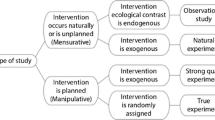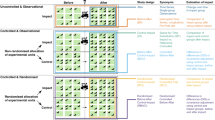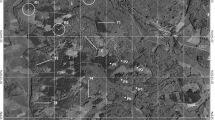Abstract
Adherence to important assumptions of statistical methods has significant ramifications for development of new knowledge in landscape ecology for two fundamental reasons: these methods will continue to be used widely and will thus affect much of the research on which advances in landscape ecology will be founded; and the degree to which statistical methods are applied appropriately will influence the statistical validity of that research. Rigorous statistical analyses are essential because no discipline can efficiently advance scientifically if one of its primary approaches for generating new knowledge is used incorrectly. Assessing and communicating compliance with statistical assumptions should be standard practice in confirmatory analyses. Better understanding of the robustness of statistical methods to deviations from assumptions can improve investigators’ decisions about which methods to apply. Explanations about the consequences of actual or possible violations of assumptions can clarify the validity of results. Many of the papers in a sample of 215 research articles published in Landscape Ecology during 2004–2013 exhibited substantial lack of clarity about adherence to statistical assumptions. Brief author statements about whether important statistical assumptions were adequately met would improve confidence in results. Ultimately, rigor and transparency in confirmatory statistical analyses will help to ensure the validity of landscape ecology research.


Similar content being viewed by others
References
Alldredge JR, Griswold J (2006) Design and analysis of resource selection studies for categorical resource variables. J Wildl Manage 70:337–346
Burnham KP, Anderson DR (2002) Model selection and multimodel inference: a practical information-theoretic approach, 2nd edn. Springer, New York
Dormann CF, McPherson JM, Araújo MB, Bivand R, Bolliger J, Carl G, Davies RG, Hirzel A, Jetz W, Kissling WD, Kühn I, Ohlemüller R, Peres-Neto PR, Reineking B, Schröder B, Schurr FM, Wilson R (2007) Methods to account for spatial autocorrelation in the analysis of species distributional data: a review. Ecography 30:609–628
Dray S, Pélissier R, Couteron P, Fortin M-J, Legendre P, Peres-Neto PR, Bellier E, Bivand R, Blanchet FG, De Cáceres M, Dufour A-B, Heegaard E, Jombart T, Munoz F, Oksanen J, Thioulouse J, Wagner HH (2012) Community ecology in the age of multivariate multiscale spatial analysis. Ecol Monogr 82:257–275
Elith J, Graham CH, Anderson RP, Dudík M, Ferrier S, Guisan A, Hijmans RJ, Huettmann F, Leathwick JR, Lehmann A, Li J, Lohmann LG, Loiselle BA, Manion G, Moritz C, Nakamura M, Nakazawa Y, Overton JM, Peterson AT, Phillips SJ, Richardson K, Scachetti-Pereira R, Schapire RE, Soberón J, Williams S, Wisz MS, Zimmermann NE (2006) Novel methods improve prediction of species’ distributions from occurrence data. Ecography 29:129–151
Giudice JH, Fieberg JR, Lenarz MS (2012) Spending degrees of freedom in a poor economy: a case study of building a sightability model for moose in northeastern Minnesota. J Wildl Manage 76:75–87
Guthery FS, Bingham RL (2007) A primer on interpreting regression models. J Wildl Manage 71:684–692
Hair JF Jr, Anderson RE, Tatham RL, Black WC (1998) Multivariate data analysis, 5th edn. Prentice Hall, Upper Saddle River
Legendre P (1993) Spatial autocorrelation: trouble or new paradigm? Ecology 74:1659–1673
Legendre P, Fortin M-J (1989) Spatial pattern and ecological analysis. Vegetatio 80:107–138
Legendre P, Legendre L (2012) Numerical ecology, 3rd edn. Elsevier, Oxford
Link WA, Barker RJ (2006) Model weights and the foundations of multimodel inference. Ecology 87:2626–2635
Maindonald J, Braun WJ (2010) Data analysis and graphics using R: an example-based approach, 3rd edn. Cambridge University Press, New York
McNutt M (2014) Reproducibility. Science 343:229
Murtaugh PA (2009) Performance of several variable-selection methods applied to real ecological data. Ecol Lett 12:1061–1068
Neter J, Wasserman W, Kutner MH (1989) Applied linear regression models, 2nd edn. Richard D. Irwin, Burr Ridge
Ott RL, Longnecker M (2001) An introduction to statistical methods and data analysis, 5th edn. Wadsworth, Pacific Grove
Seaman JW, Jaeger RG (1990) Statisticae dogmaticae: a critical essay on statistical practice in ecology. Herpetologica 46:337–346
Sokal RR, Rohlf FJ (2012) Biometry: the principles and practice of statistics in biological research, 4th edn. W.H. Freedman, New York
Wagner HH, Fortin M-J (2005) Spatial analysis of landscapes: concepts and statistics. Ecology 86:1975–1987
Williams BK (1983) Some observations on the use of discriminant analysis in ecology. Ecology 64:1283–1291
Zar JH (1999) Biostatistical analysis, 4th edn. Prentice Hall, Upper Saddle River
Acknowledgments
We thank Brian S. Cade, Kurt H. Riitters, Guiming Wang, and two anonymous reviewers for advice about the paper, and Baylor University for financial support.
Author information
Authors and Affiliations
Corresponding author
Rights and permissions
About this article
Cite this article
Gutzwiller, K.J., Riffell, S.K. Rigor and transparency in statistical analyses can help to ensure valid research. Landscape Ecol 29, 1115–1122 (2014). https://doi.org/10.1007/s10980-014-0063-6
Received:
Accepted:
Published:
Issue Date:
DOI: https://doi.org/10.1007/s10980-014-0063-6




